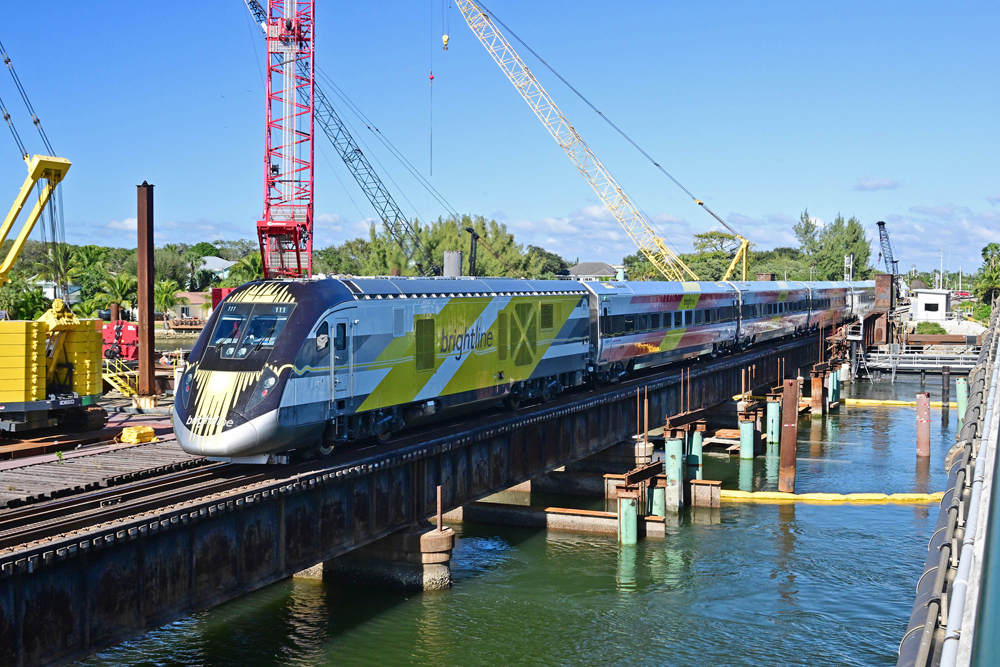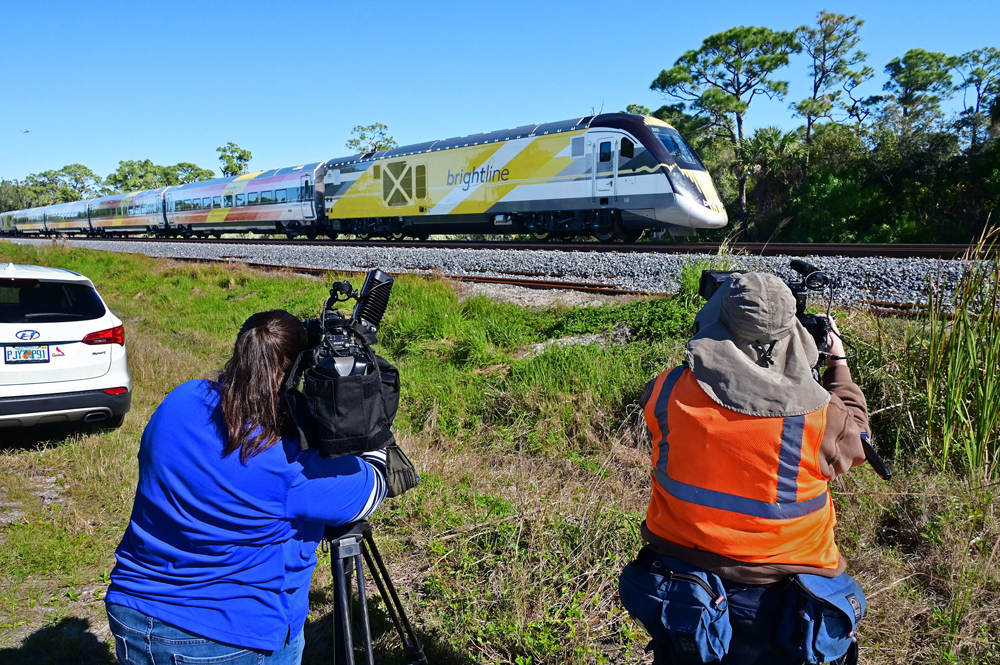
WEST PALM BEACH, Fla. — The next chapter in Brightline’s plan to connect Miami and Orlando with modern intercity passenger trains began Tuesday with the first route familiarization runs for operating crews.
Tuesday’s train made a round trip to Micco, Fla., which is midway between Melbourne and Vero Beach, Fla., and 90 miles north of Brightline’s West Palm Beach maintenance facility. A second Florida East Coast Railway main track is being restored another 35 miles north to Cocoa, Fla., where an entirely new right-of-way is being constructed to an already-completed station at Orlando International Airport. A test train scheduled for a West Palm Beach-Cocoa round trip today (Wednesday, Jan. 19), has been cancelled; the first West Palm Beach-Cocoa round trip is now scheduled for Thursday, Jan. 20, departing West Palm Beach about 7 a.m.
Unlike most railroad qualification runs and testing elsewhere, this one was highly publicized by Brightline, in part to illustrate the progress the company has made since construction began in 2019. The route is more than 70% complete, and service is expected to begin in early 2023 after the Orlando-Cocoa segment is finished and all West Palm-Cocoa capacity improvements are in place.
One of the most significant investments is being made at Jupiter, Fla., where an aging drawbridge over the Loxahatchee River is being replaced with a new double-track span. All other bridges along the route are being refurbished or replaced before passenger service begins, except for the single-track drawbridge at Stuart, Fla.
Although familiarization runs will be limited to 60 mph, FEC’s current freight speed limit, Brightline trains will eventually be permitted to travel at 110 mph on the West Palm Beach-Cocoa segment. That’s where highway grade crossing monitoring systems are being installed as a part of Wabtec’s I-ETMS positive train control signal system, which must undergo reliability certification at that speed. On the sealed corridor under construction between Cocoa and Orlando, trains will be permitted to operate at 125 mph once the system is certified by the Federal Railroad Administration. The existing I-ETMS passenger train maximum is 90 mph.
Publicizing the testing activity, which is expected to continue through the end of 2022, calls attention to local residents that they should expect increased train traffic on the route. Since Brightline’s Miami-West Palm Beach service resumed in November 2021, after a service suspension that began in March 2020, there have been many vehicle collisions and trespasser fatalities, and the company has made significant safety outreach efforts in communities along the original route. Coverage of Tuesday’s qualification runs is a first step in raising awareness of what’s ahead for Treasure Coast residents.
— Updated at 8:05 a.m. CST with cancellation of trip planned for Wednesday.















The track through downtown Stuart and Jensen Beach Florida go through the middle of a small traffic rotary(roundabout) and is difficult to drive through when no train is coming.I can not see how any train could go faster than 60 mph at these locations, due to this and a lot of pedestrians also! There will be a alot of accidents. West Palm beach has an upgraded connecting track from FEC to CSX about1/3 mile long that Brightline could use and follow CSX right of way for about 8 miles out of town where your in the middle of nowhere and turn north on their own right away to Orlando airport about 100 miles through very desolate land.Another location is at Hobe Sound by Dickeson state park you could head northeast beside park to interior FL on new right of way.For Bright line to attract passengers they need to get travel time Miami to Orlando under 2 1/2 hours. I am enjoying the sunny weather for 2 months vacation, and will explore the area further. STAY TUNED
Derrick,
Not all trains leaving Miami Central will be making all stops. Many will be express and make no stops or very few. Many of the other trains will have intermediate stops, but from what I have read, there will not be a “local” which makes *all* stops. As has been discussed previously, Brightline is a partnership deal with FEC’s owner, so using CSX ROW is not really what they had in mind. They (Brightline) said trains will reduce speed depending on the conditions of the ROW and how it passes through the municipality involved. As long as the signals are working properly I wouldn’t expect any accidents unless a driver outright ignores them.
FWIW: I have been in the Orlando Transportation Center where the Brightline airport station will be. It is very easy to get around and to be honest the tote boards look just like any other airport terminal. Hopefully someday I will be able to look up and see not just Brightline departures and arrivals, but SunRail as well.
I wish Amtrak would get equal access to the airport terminals for 100% transfer ability. Luggage claims, ticketing, rental cars and other services all in the same building.
Problem with a train to the airport is that many airports are so big that the airport needs a local distributor system from the train to the various terminals.
At first glance, Boston’s newish Silver Line seems to be substandard because it’s a glorified bus, not a train. But it works as it goes to all terminals. Slow uncomfortable and crowded, at least it’s a one-seat ride from downtown to the airport’s various destinations.
The sleek front nose design of Brightline’s Siemens Charger locomotives should be emulated by Amtrak on its new Charger locomotives. The new Charger units delivered to Amtrak so far have the chopped front look. Make them look like part of the 21st century, not 1970s “boxy” like Amtrak’s first new locomotives from EMD and GE.
Is there any plan on the part of Florida DOT or the counties involved to build overpasses and eliminate crossings? If requested, would Brightline agree to fence in the ROW in places were communities want it?
I’m not sure of any plans and I assume that some of the rail crossings also involve county and site owned streets, roads. The Infrastructure bill had some significant funds for rail crossing safety as well as a pot for freight rails so their is a pot of federal funds that could be used and sure that if opportunity presents itself the parties involved, railroad and public entities, would take the opportunity
Alexander, Under current FDOT regs, the local municipality would have to fund all crossing upgrades or overpasses. Depending on the (cooperative) town involved Brightline has offered to contribute funding to upgrading the crossing and signals, and in a couple of places Brightline agreed after negotiations to pay 100%.
One locality refused to pay anything for the crossing and the FEC made plans to close the crossing. Finally the municipality went to the Florida Legislature and asked them to pay for it so they wouldn’t lose the crossing. Cooler heads prevailed and *some* funding is going to come via FDOT to help towns who can’t afford the needed upgrades.
Some towns with crossings don’t even have gas stations in them and don’t generate a large amount of revenue to pay for these higher quality crossings. They in turn look to their county governments to make the needed investments.
Brightline will be fencing in their ROW where the surrounding population or tresspassing habits demand it. But there are environmental issues to fencing in the entire ROW, migratory animals just for starts.
Brightline may wish to consider partnering with Operation Lifesaver to enhance public awareness of the increased activity in this corridor. See Tracks, Think Trains.